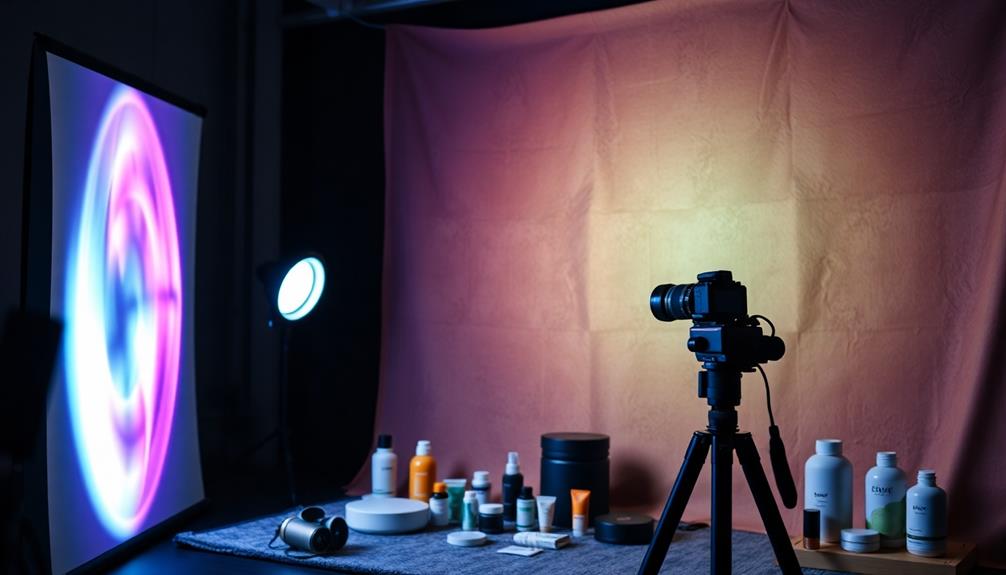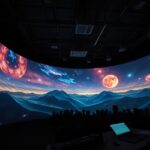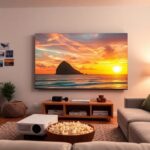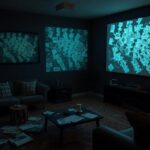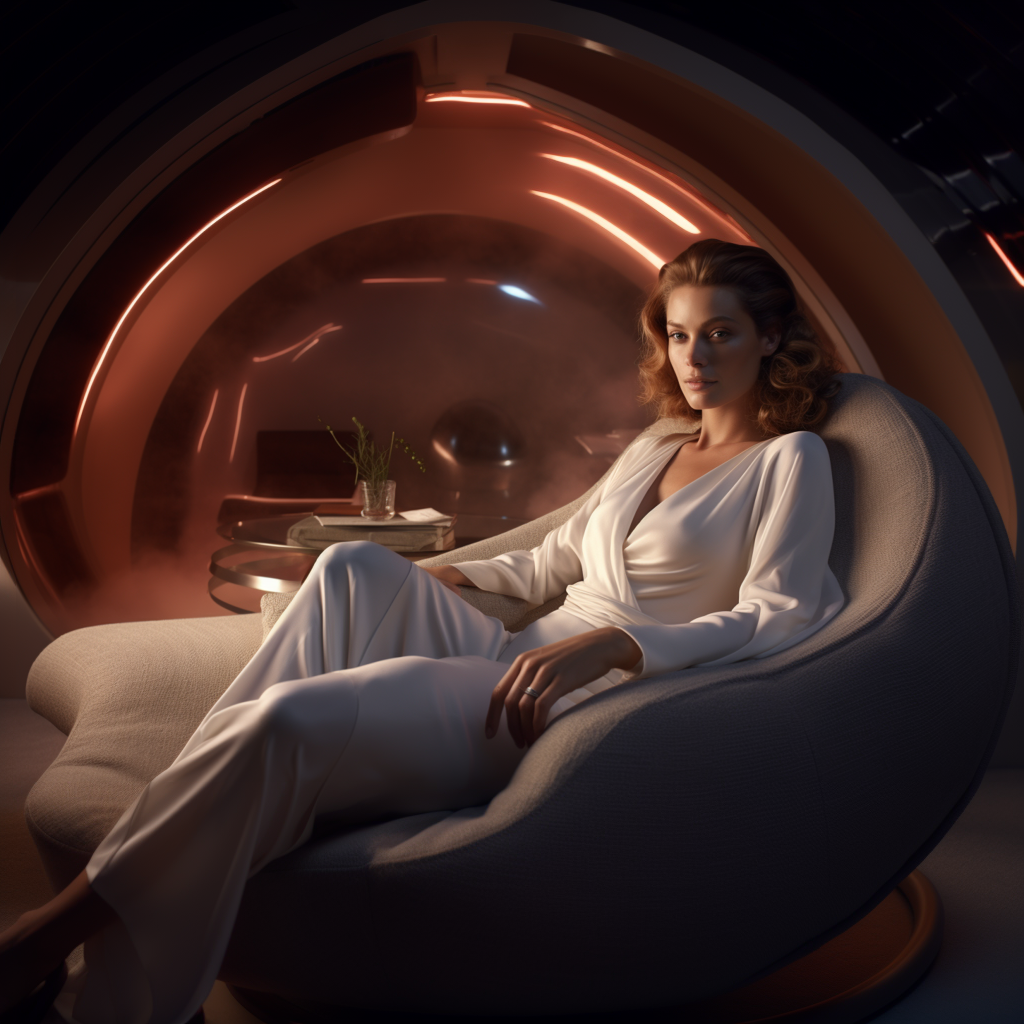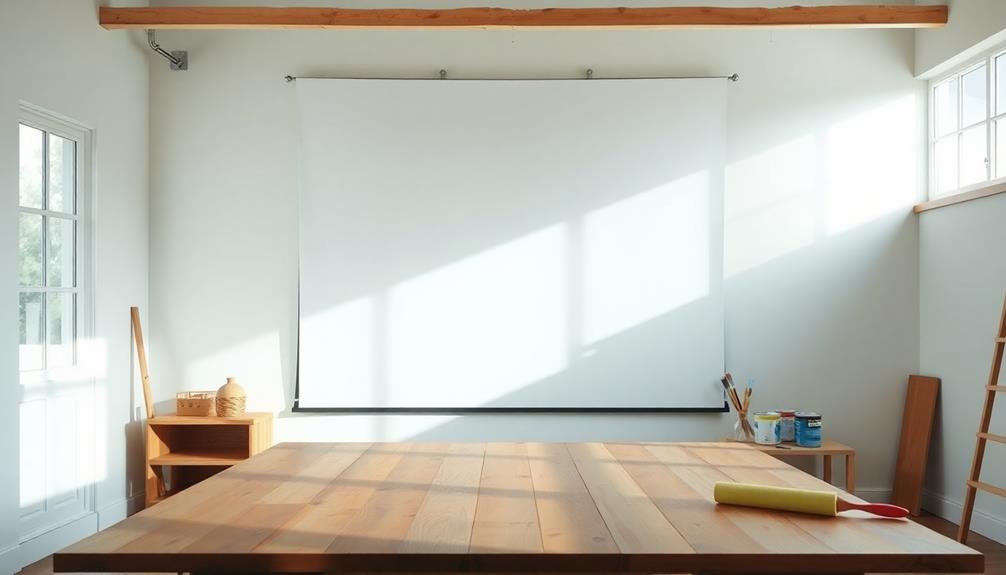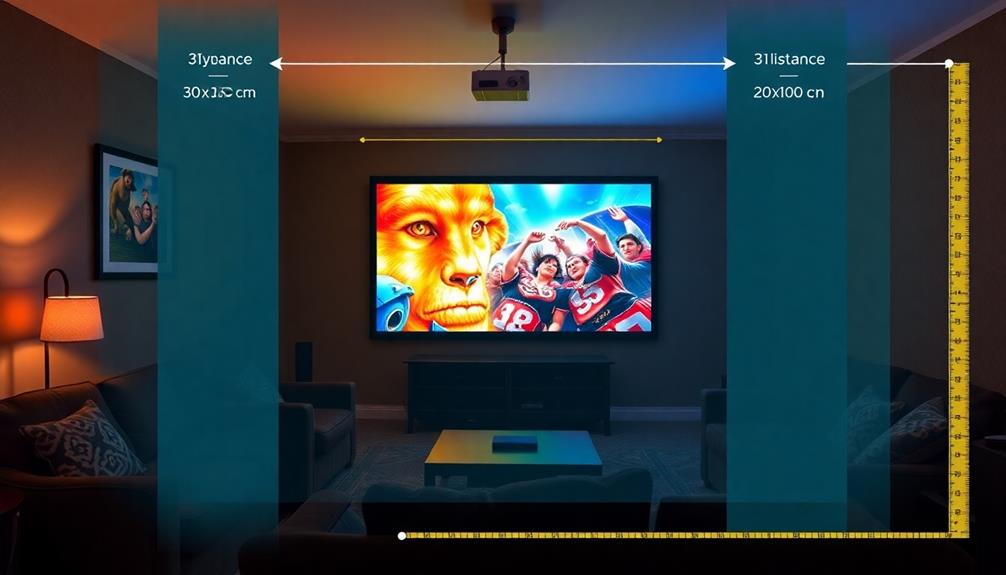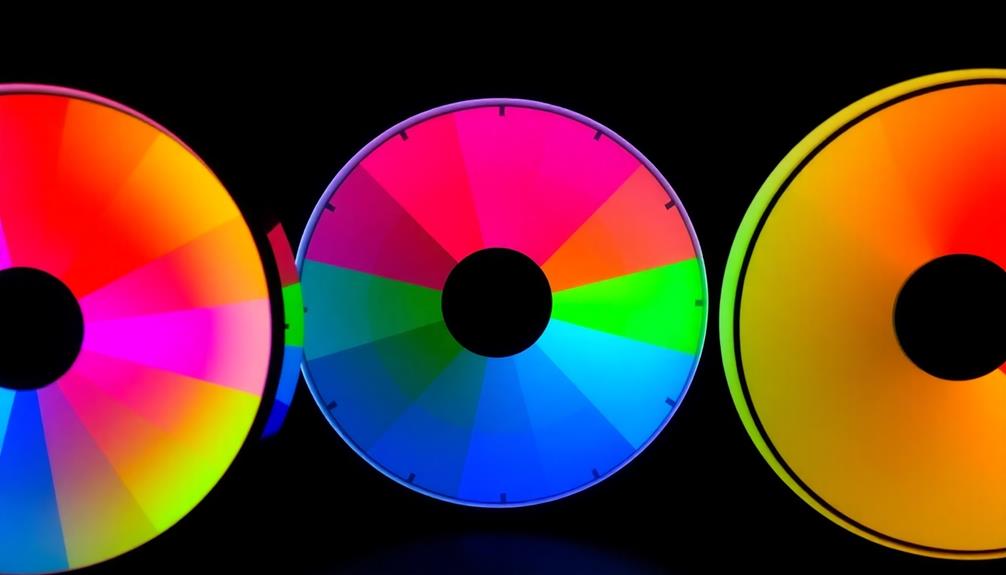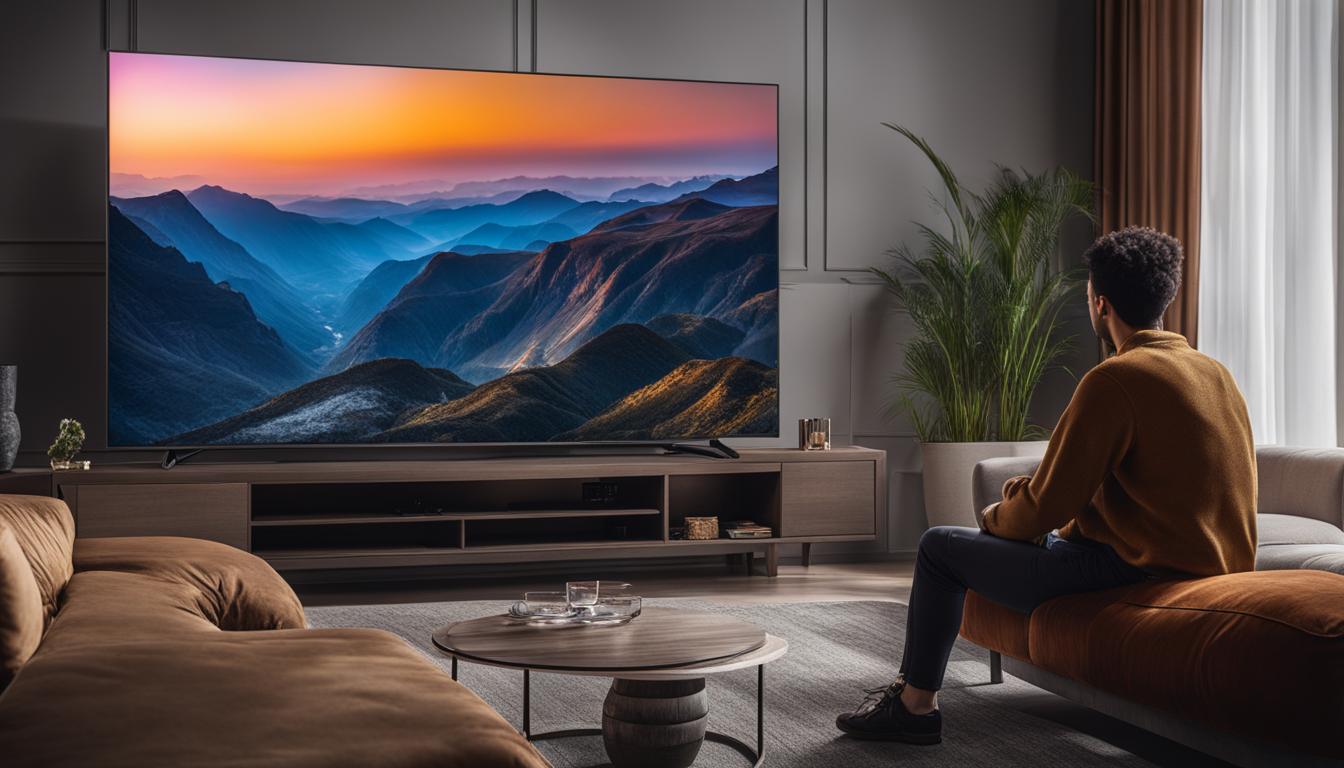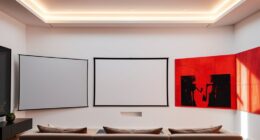Creating immersive art installations with multiple projectors transforms viewer experiences by engaging them deeply. You'll want to start by defining a clear theme and planning your setup for ideal projector coverage. Choosing high-resolution projectors and utilizing projection blending software will enhance visual coherence. Don't overlook geometric alignment to prevent distortions and guarantee seamless visuals. Incorporate interactive elements to make your audience active participants. Collaboration with other artists can further enrich the narrative and emotional impact of your work. By exploring innovative techniques, you'll create an unforgettable immersive experience that resonates long after the audience leaves. The journey doesn't stop here.
Key Takeaways
- Define a cohesive theme and objective to guide content creation and equipment selection for your immersive installation.
- Prioritize high-resolution projectors and utilize projection blending software to ensure seamless visuals across multiple projectors.
- Implement geometric alignment techniques to minimize distortion and enhance the overall visual quality of the projections.
- Incorporate interactive elements that encourage audience participation, fostering deeper emotional connections and unique experiences.
- Collaborate with other artists and technologists to enrich the creative process and expand the immersive experience's impact.
Importance of Immersive Art

Immersive art is important because it transforms the way you experience creativity and connection. Through immersive installations, you engage with art in a dynamic manner, becoming an active participant rather than a passive observer. Notable examples, like teamLab's Borderless and Yayoi Kusama's Infinity Rooms, showcase how these interactive experiences create emotional connections that traditional art forms often lack.
The power of projection mapping and interactive elements allows spaces to evolve based on your interactions, making each visit unique. Since the 1960s, immersive art has remarkably grown, especially with digital technologies emerging in the 2000s. This evolution has paved the way for greater interactivity and personalization, allowing you to shape your experiences in ways that resonate with you.
Moreover, the emotional engagement you find in immersive art surpasses that of conventional mediums, deepening your connection to the artwork. The rise of social media amplifies these experiences, encouraging you to share and connect with others.
As we look ahead, the integration of AI and sustainable practices is set to redefine immersive art, fostering collaboration between artists and technologists to create innovative installations that enrich your experience.
Planning Your Installation

When planning your immersive installation, start by defining a clear theme and objective that will guide your content and equipment choices. This foundation will help you maintain focus and create a cohesive experience.
Next, assess the venue's dimensions and conditions. This assessment is essential for determining the number of projectors you'll need for ideal coverage and visual impact. Consider the top projectors for gaming enthusiasts as references for high-performance equipment that can enhance visual experiences.
Carefully plan the geometric alignment of your projectors. This guarantees seamless blending and minimizes distortion. Utilize projection mapping software for precision in your setup.
A detailed layout is also vital; include the placement of projectors, screens, and interactive elements to enhance visitor engagement and guarantee accessibility.
Consider incorporating a multi-channel video projection system. This can create a cohesive audiovisual experience, allowing for high resolutions—up to 7680×1200 with three projectors—for stunning visuals.
By meticulously planning each aspect of your immersive installation, you can create an enchanting environment that draws visitors in and keeps them engaged.
Equipment Selection and Setup
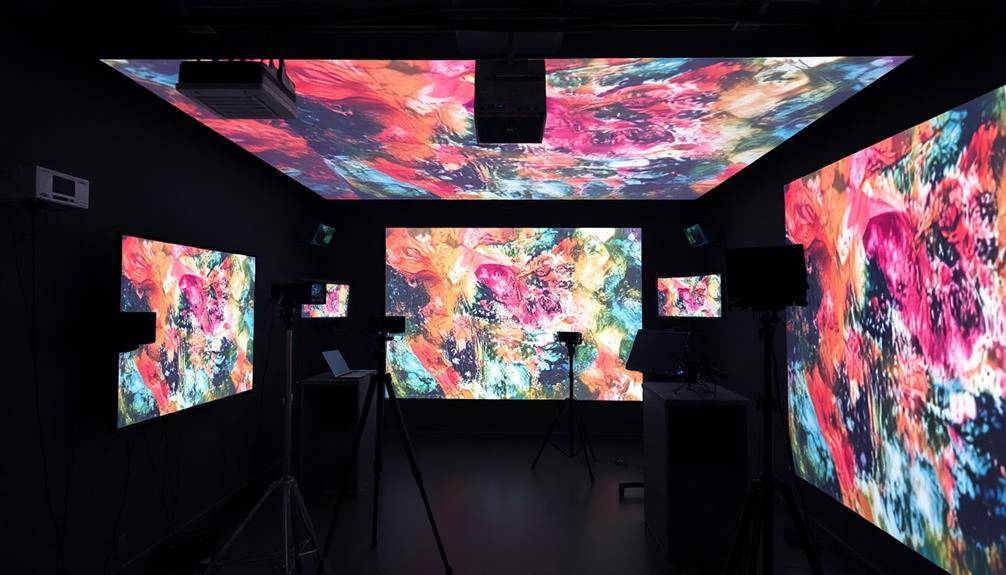
Selecting the right equipment can make or break your immersive art installation. When it comes to equipment selection, you'll want to prioritize quality and functionality to achieve stunning immersive projection.
Here are three essential items to evaluate:
- High-Resolution Projectors: Opt for models like the Optoma GT1080 Darbee Short Throw Projectors. They deliver excellent visuals and work well in tight spaces, making them ideal for multi-projector setups.
- Video Wall Controllers: Use a device like the BIT-MSE-4K60 series to connect multiple projectors to a single PC. This setup allows for cohesive displays and simplifies your content management process.
- Projection Blending Software: Incorporate software that can seamlessly combine images from different projectors. This will enhance the immersive quality of your installation, creating a unified visual output.
Additionally, employing automation tools like Brightsign HD1020 media players can streamline operations, ensuring your projectors activate automatically upon media connection.
Geometric Alignment Techniques

Mastering geometric alignment techniques is fundamental for delivering a truly enchanting immersive experience. When you're working with multiple projectors, guaranteeing that your video projection blends seamlessly is critical. Here's a quick overview of key aspects to take into account:
| Aspect | Importance |
|---|---|
| Seamless Blending | Guarantees no visible seams or distortions |
| Planning | Anticipates venue conditions for smooth setup |
| Technician Expertise | Essential for effective execution |
Utilizing various software and hardware options can enhance your geometric alignment capabilities, making it easier to achieve professional results. Even if you don't have extensive imaging knowledge, the right tools can greatly improve your projection mapping accessibility.
While the learning curve for these technologies can be steep, the return on investment is worth it, as it leads to enhanced visual quality and greater audience engagement. Careful planning and technician expertise are imperative, especially since unexpected venue conditions may pose challenges during installation. By focusing your efforts on geometric alignment, you'll create a more immersive and enthralling experience for your audience.
Content Creation Strategies
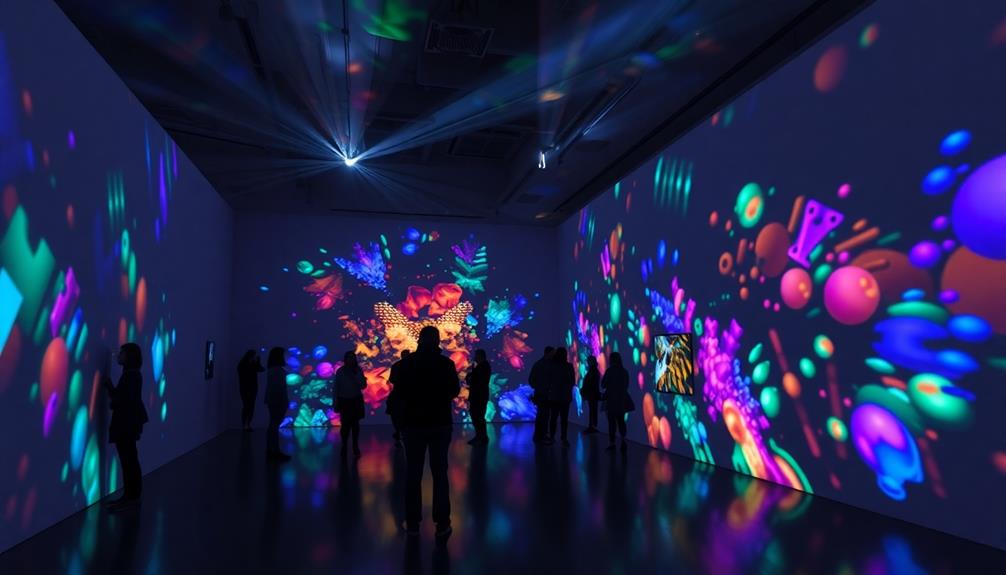
Creating compelling content for immersive art installations requires a thoughtful blend of diverse media to engage your audience. To achieve this, consider the following content creation strategies:
1. Incorporate diverse media: Use high-resolution images, videos, and interactive elements to involve viewers. This variety enhances the overall experience and keeps visitors intrigued.
Additionally, leveraging intelligent tutoring systems can offer personalized experiences that may inspire innovative approaches to content creation.
2. Utilize projection blending software: To create a seamless visual quality across multiple projectors, leverage advanced software. This guarantees that your installations look cohesive and truly immersive, enhancing the viewer's journey.
3. Focus on themes and narratives: Crafting a strong narrative or theme allows for deeper emotional connections with your audience. This approach makes the experience not just enjoyable, but also memorable.
Don't forget the power of interactive installations. Integrating real-time responses based on audience movement or input personalizes the experience, fostering active participation.
Collaboration with artists and technologists can also lead to innovative solutions, merging creative visions with technical prowess. By implementing these strategies, you'll create engaging content that resonates with your audience and elevates your immersive art installations.
Audience Engagement and Interaction
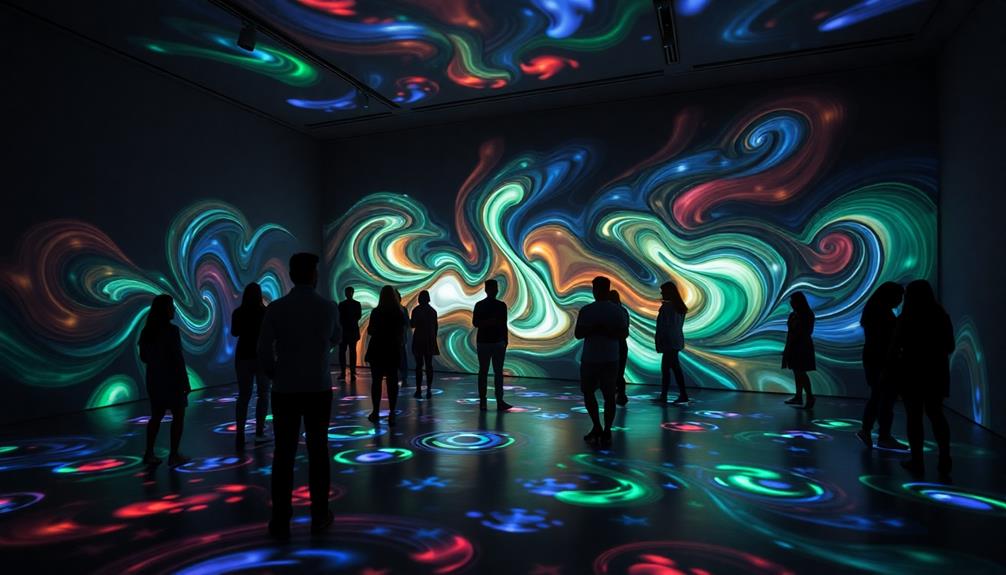
When you step into an immersive art installation, you're not just a spectator; you're part of the experience.
These spaces foster emotional connections, inviting you to share your own stories and engage with the art on a deeper level.
Interactive elements enhance your experience, making each visit uniquely yours and encouraging you to return for more.
Emotional Connections Through Art
Art has a remarkable ability to forge emotional connections, transforming passive viewers into active participants in their own narratives. When you step into an immersive installation like "Considerations of Infinity," you're not just observing; you're engaging with the art on a deeply personal level.
This interactive experience invites you to reflect on your own journey, creating a shared sense of vulnerability and connection among attendees. In the same way that virtual birthday parties can honor memories and foster connections, immersive art installations create spaces for shared experiences and collective storytelling.
Here are three ways immersive art can spark emotional connections:
- Personal Storytelling: The installation fosters an environment where you can share your stories of love, depression, and healing, which resonate with others.
- Collective Energy: Each interaction generates unique energy, enhancing the emotional weight of the experience and making you feel part of something bigger.
- Sensory Engagement: The carefully designed projections evoke sensory experiences that elicit powerful emotional reactions, deepening your connection to the art.
Interactive Audience Participation
In immersive art installations, interactive audience participation transforms viewers into active contributors, reshaping the way you experience the artwork. By incorporating interactive elements like sensors that respond to your movements or sounds, these installations create dynamic and personalized experiences.
You'll find that projection mapping technology enhances your engagement, allowing visuals to change in real time based on your actions.
Imagine stepping into a project like the Immersive Box, where you can customize your experience through a tablet. You get to tailor elements such as colors and music to suit your preferences, making the immersive experience uniquely yours.
Motion tracking technologies, like Blacktrax, enable precise interactions that influence visual outputs during performances.
As you engage with these immersive environments, you become an active participant rather than just a passive observer. This involvement fosters deeper connections and emotional responses, enriching your overall experience with the art.
Unique Viewing Experiences
Experiencing immersive art installations offers a unique opportunity to engage with art in ways you mightn't have imagined.
These installations foster emotional connections, turning passive observation into active participation. As you navigate through them, you'll find that each visit can evoke different reflections and feelings.
Here are three ways these unique viewing experiences enhance your engagement:
- Interactive Elements: Many installations incorporate responsive projections that react to your movements, allowing you to influence the artwork directly. This transforms you from a mere observer into a crucial part of the installation.
- Looping Presentations: With many immersive art experiences designed to loop, you might find yourself staying longer. Each repeat reveals new layers, creating a shared journey with others who are also captivated by the art.
- Personal Spaces: Installations like "Considerations of Infinity" turn familiar environments into immersive environments, inviting you to experience the art on a deeply personal level. This intimate connection can lead to profound emotional responses.
In essence, these immersive art installations elevate your engagement, creating lasting memories and connections.
Technical Challenges to Consider

When creating immersive art installations, you'll face several technical challenges that can impact the overall experience. One of the most vital aspects is guaranteeing geometric alignment. If your projectors aren't set up correctly, you'll encounter visual distortions that can detract from the immersive effect.
Additionally, managing power distribution is essential. For example, keeping five projectors on one circuit while having five media players on another can prevent overload and guarantee consistent performance.
You'll also need to utilize projection blending software to achieve seamless visuals. This is especially important in installations with multiple projectors, as edge blending is necessary for creating a cohesive image.
Don't forget to address unexpected venue conditions, such as lighting or surface textures, since these factors can greatly influence the effectiveness of your projected content.
Collaboration With Other Artists

When you collaborate with other artists, you open up a world of creative possibilities that can enhance your work.
By integrating diverse perspectives and skill sets, you can create immersive experiences that resonate more deeply with audiences.
Plus, working together fosters a sense of community, allowing you to share resources and inspire innovative ideas.
Benefits of Artistic Collaboration
Embracing artistic collaboration in immersive installations can greatly enhance your creative process. When you work alongside other artists, you tap into a wealth of diverse perspectives, techniques, and mediums.
This synergy can lead to innovative and multifaceted art installations that captivate audiences in ways you mightn't achieve alone. Here are three key benefits of collaboration:
- Resource Sharing: Collaborating allows you to pool equipment, expertise, and funding. This can make complex, technically sophisticated installations possible, expanding your artistic capabilities.
- Community Engagement: Working with fellow artists fosters a sense of community and support. Through networking and cross-promotion, you can reach new audiences and enhance the impact of your work.
- Richer Narratives: Different artistic styles and concepts can intertwine to create deeper emotional engagement for viewers. This extensive storytelling experience resonates more profoundly, enriching the overall art installation.
Creative Process Integration
Creative process integration in immersive art installations thrives on collaboration with other artists, unearthing a treasure trove of diverse ideas and techniques. When you work alongside fellow creators, like in the Vibe of Asheville Creators Project, you tap into a rich pool of artistic disciplines, from visual arts to music and interactive technology.
This collaboration not only enriches the sensory experience but also leads to innovative concepts, such as the interactive elements developed in projects like Zerospace.
Careful planning is essential for these joint efforts. You'll find that integrating feedback from peers, like the guidance from projection artist Adam Larsen, can greatly enhance both the technical execution and your artistic vision.
Each artist brings their unique strengths to the table, allowing for exciting new approaches—especially when creating features like a stunning video wall.
Documenting this collaborative journey, perhaps through a behind-the-scenes film, can provide valuable insights into teamwork dynamics and inspire future projects.
Involving others in the creative process transforms your installation into a shared experience, making it not just a display of art but a reflection of collective creativity.
Diverse Perspectives in Art
Collaboration with other artists opens the door to a wealth of diverse perspectives, enriching immersive art installations in remarkable ways. When you engage in collaborating, you not only expand your creative horizons but also enhance the overall experience for your audience.
Here are three key benefits of working with fellow artists:
- Integration of Media: By combining different techniques—like projection mapping with live performances—you create a multilayered narrative that captivates viewers. Jesse James Allen's work beautifully exemplifies this fusion of sound and visuals.
- Community Engagement: Collaborative events, such as those organized by Kira Bursky, highlight the talents of multiple artists while fostering a supportive environment. This encourages community participation and dialogue around immersive art.
- Resource Sharing: When artists pool their resources and technical expertise, they can undertake ambitious projects that might be unfeasible alone. This collaboration results in unique artistic expressions, blending various styles and experiences into one cohesive installation.
Incorporating diverse perspectives through collaboration not only enriches your work but also provides audiences with multifaceted, immersive art experiences that resonate on multiple levels.
Future Trends in Projection Art

As projection art evolves, artists are increasingly harnessing the power of AI and generative algorithms to create personalized and interactive experiences for viewers. This integration allows for dynamic installations that respond to audience engagement, making each interaction unique.
Imagine stepping into a space where the art shifts and transforms based on your movements or choices—this is the future of projection art.
Advancements in projection mapping technology, including 8K resolution and improved edge blending, enhance the visual quality and immersive nature of these installations. You'll find that the clarity of visuals captivates and draws viewers in deeper than ever before.
Additionally, artists are now focusing on sustainable materials and energy-efficient technologies, reflecting a commitment to environmentally conscious practices.
Collaboration between artists and technologists opens doors to innovative works that challenge traditional perceptions of space and audience engagement.
Social media's role in amplifying visibility can't be overlooked either; it drives a trend towards creating visually striking, shareable experiences that resonate with a digital audience.
As you explore the world of projection art, expect these trends to redefine how you connect with art in profound ways.
Frequently Asked Questions
How to Create an Immersive Art Installation?
To create an immersive art installation, start by defining a strong theme. Incorporate engaging visuals, sounds, and interactive elements that invite participation. Carefully plan the layout to enhance exploration and foster emotional connections with your audience.
What Is Immersive Projection?
You know what they say: seeing is believing. Immersive projection transforms spaces into enchanting environments, using multiple projectors to create dynamic visuals. It engages you, making every interaction a unique, sensory experience that's hard to forget.
How to Create an Immersive Room?
To create an immersive room, you'll want to focus on dynamic visuals, surround sound, and engaging content. Arrange elements thoughtfully, encouraging exploration, while ensuring lighting and sound design enhance the overall experience for your audience.
How to Become an Installation Artist?
Becoming an installation artist is like planting a garden; you need research, networking, and technical skills to cultivate creativity. Engage with others, explore your vision, and share your work to help it blossom.
Conclusion
In creating immersive art installations with multiple projectors, you're not just lighting up a room; you're painting an entire universe. Imagine stepping into a kaleidoscope where each facet shifts and dances with your movements. Like musicians harmonizing, every projector and piece of content must sync seamlessly to create an unforgettable experience. As you navigate technical challenges and audience interactions, remember that each installation is a living tapestry, weaving together art and technology to captivate the senses.
Hi, I’m Dominique. I love movies and want everyone to have the best home cinema experience possible. That’s why I started 1home Theatre Projector. We help people build their home cinema system using the latest technology and news on laser tv and all-around home entertainment.
We’re a small team of movie buffs (and experts) who are passionate about giving our readers the best advice and information possible. So whether you’re just starting out or you’re looking to upgrade your home cinema system, we’ve got you covered!

